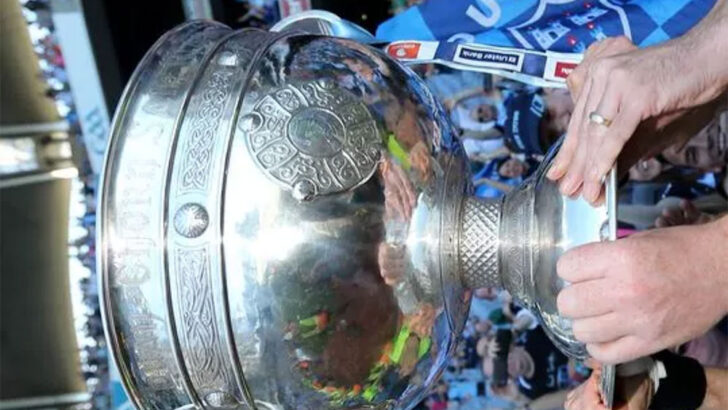Going for Glory, Irish Style
Chasing Sam Maguire; The All-Ireland Football Championship 1928-1977
by Dermot Reilly and Colm Keys, foreword by Larry McCarthy (The O’Brien Press, €34.99 / £32.99)
This is a comprehensive account of the All-Ireland Senior Football finals from 1928 to 1977. On each occasion the teams competed for the Sam Maguire Cup.
Sam Maguire, to whom the cup was dedicated, was born in Dunmanway, Co Cork, on March 1 1877. He migrated to London where he found employment in the Post Office. He joined the GAA and was an active member both as an administrator and a player. Soon after arriving in London, he became a member of the Nationalist secret society Irish Republican Brotherhood, and later swore Michael Collins into the organisation in 1909. It was the IRB that before 1916 worked to move the Irish Volunteers in the direction of a revolutionary act at Easter Week
During the War of Independence, he was in charge of IRA intelligence in London. He was also Collins’ principal contact in London for purchasing arms and smuggling them to Ireland. Influenced by Collins, Maguire supported the Anglo-Irish Treaty.
After the establishment of the Irish free State Maguire returned to Ireland and secured employment in the Department of Posts and Telegraphs.
Remaining close to his old comrades in the IRA, some of whom were also members of the secret oath-bound Irish Republican Brotherhood, he conspired with a few of them when they initiated a ham-fisted mutiny in the Irish Free State army. This arose out of the new government’s wish to downscale the number of men under arms, and to initiate a smaller, more suitable, less costly army. The time had come to replace the amateur revolutionaries with professional soldiers.
Following the quick bloodless suppression of the mutiny, he was dismissed from his post in the civil service in 1926 and, despite subsequent appeals that he be re-installed, he remained unemployed. He returned to Dunmanway destitute and died on February 6 1927.
Maguire’s former comrades were determined that his sterling contribution to the struggle for independence should not be forgotten. They donated the Sam Maguire Perpetual Memorial Cup to be awarded to the winners of the All-Ireland football final to replace the previous cup which had been lost.
The trophy, based on the design of the Ardagh Chalice, was first presented in 1928 to the captain of the Kildare team. It was retired in 1988, and for award purposes was replaced by a replica in 1988. The original is now on display in the GAA museum at Croke Park.
In their 464-page chronicle of the All-Irelands, Dermot Reilly and Colm Keys provide a treasure trove of information, which will delight the hearts and souls of all GAA fans, here and abroad.
There are accounts of the various victories by the finalists before they reached All-Ireland final day. There is a detailed account of each final. The two teams are listed together with their substitutes. The referee’s name and the attendance figures and gate receipts are given.
Under the heading ‘The Year that Was’ the authors paint in a picture of the background against which each final was played. For instance, they note that in 1928 Irish coinage was circulated for the first time. In sharp contrast they recall that on September 1 1939 Germany invaded Poland and thus began World War II which over the following six years would claim over 56 million lives.
The 1947 All Ireland Football final was played in the Polo grounds in New York. Canon Michael Hamilton was chiefly responsible for this arrangement. Fr Hamilton was chairman of the Clare County Board and while serving on the Munster and Central Councils, he successfully proposed that as part of commemorations of the Great Famine the All-Ireland Football final be moved to New York.
The match was between teams from Cavan and Kerry, with Cavan emerging victorious. The playing conditions were challenging. There was the sweltering heat and the condensed dimensions of a rock-hard pitch in the centre of which was an elevated pitcher’s mound.
During the match Eddie Dowling, one of the Kerry players, fell and struck his head on the baseball mound. This left him lying unconscious for seven days and seven nights in a New York hospital and delayed his return home. The attendance at that match was 34,941 and the gate receipts some £38,000 (€48,250). The event provided priceless publicity for the GAA and its games on the other side of the Atlantic.
This admirable publication, replete with information and practical statistical information, will be warmly welcomed by supporters and non-supporters of the GAA alike.


 Dublin fans reach out to touch the Sam Maguire Cup
Dublin fans reach out to touch the Sam Maguire Cup